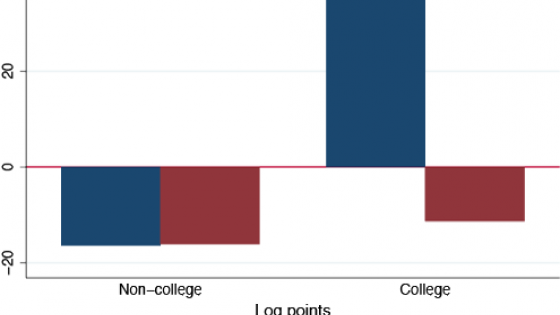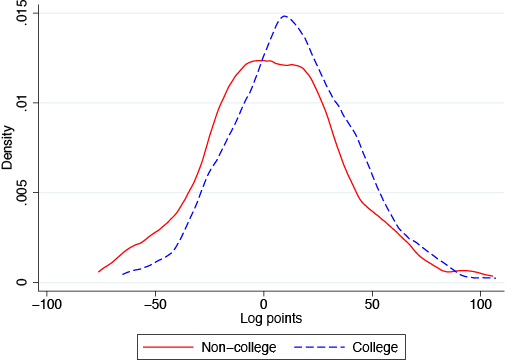There is a general consensus among economists that biased technical change and offshoring are two important drivers of increasing skill premiums and job polarisation in advanced economies. At the same time, there is considerable uncertainty about their relative importance, as they are typically not observed separately.
The observational equivalence of offshoring and biased technical change
To see this, suppose that a firm's production technology does not change, but it decides to relocate unskilled production stages abroad. As a result, the use of unskilled workers at home declines. Alternatively, suppose that there is no offshoring, but a change in technology biased against the use of unskilled work, for example through automation. The impact on demand for domestic labour is comparable in both cases, such that the effects of offshoring and biased technical change are observationally equivalent. However, for many theoretical as well as empirical questions, we would like to be able to distinguish between these two drivers of factor demand (Feenstra and Hanson 2003).
In a recent paper, we aim to solve the observational equivalence problem (Reijnders et al. 2016). The general approach until now has been to set up a cross-country (cross-industry) regression in order to explain labour demand changes by indicators of a job’s potential to be affected by biased technical change, or its potential to be offshored. For example, Goos et al. (2014) and Michaels et al. (2014) organise such a ‘horse race’ and argue that the negative effect of biased technical change on the demand for less-skilled workers was much stronger than the effects of offshoring. However, these studies analyse only part of the production process, namely, the stages which are carried out at home. We argue that in the presence of offshoring, biased technical change can only be observed when analysing all stages of production, both at home and abroad. We do so using new data on the factor content of imported intermediates, and thus provide a clean route to measure the effects of actual, not potential, biased technical change.
Following Antràs and Chor (2013), we refer to a vertically integrated production process that spans multiple countries as a global value chain (GVC). To frame our empirical work, we develop a basic model where GVC production needs several types of tasks. Each type requires the input of a single factor and can take place at home or abroad. Given task prices, a firm chooses the intensity with which each of the tasks is performed within the GVC. We derive the optimal task demands and the corresponding factor cost shares and show how these are affected by the interplay of task allocation across countries, national factor prices, and biases in technology.
Measuring biased technical change in global value chains
We map final goods to value added by labour and capital in any country in the world. The general idea is to net out intermediate inputs using information on the input-output structure of the world economy, following Valentinyi and Herrendorf (2008) and Los et al. (2015). We study 291 GVCs of manufacturing products, of which the last stage of production takes place in an advanced country using the World Input-Output Database (WIOD, see Timmer et al. 2015). Figure 1 shows changes in the factor costs shares in GVCs. The cost shares of college educated workers and capital increased rapidly, while non-college educated workers’ shares declined strongly. This is a pervasive pattern, found for 280 out of 291 GVCs in the case of non-college educated workers (on average 8.2% decline) and similarly in 280 GVCs for college educated workers (on average 4.4% increase). At the same time we find an increasing capital cost share in 223 GVCs, with a 3.8% increase, on average.
Figure 1. Change in factor cost shares in GVCs, 1995-2007
Notes: Kernel density of change in cost shares in GVCs for three factors: college and non-college educated labour and capital. There are 291 observations for GVCs of manufacturing products.
Figure 2 shows the Kernel density plot for the (log) change in average task prices in our set of GVCs over the period 1995-2007. This is the price paid for the factor that carries out the task, averaged across all countries that participate in a particular GVC. The price changes of an hour of a non-college task (solid line) and a college task (dotted line) are given relative to the change in the price of capital. Non-college task prices have declined by, on average, 8.4 log points relative to college tasks, and both labour tasks have become more expensive relative to capital. The average price paid for capital tasks declined by 5.3 log points relative to non-college tasks, and 13.7 log points relative to college tasks.
Figure 2. Change in relative task prices in GVCs, 1995-2007
Notes: Kernel density of change in task prices of college and non-college educated labour in GVCs, relative to capital. There are 291 observations for GVCs of manufacturing products.
We use a system of GVC cost share equations, as in Michaels et al. (2014), to estimate task price elasticities and biases in technical change. In contrast to traditional analyses based on data for domestic stages of production only, we do not need to control for the effects of offshoring in our regressions, as both domestic and foreign factor uses are already accounted for. We find that the overall bias effects of technical change are not only statistically significant, but also economically highly significant as they explain the majority of the cost share changes. In contrast, we find that factor price developments can only explain a minor part. This main result is shown to be robust to various alternative specifications.
Employment effects of offshoring and biased technical change
With a clean estimate of BTC, we revisit the debate on the drivers of labour demand in advanced countries in a simple exercise. We simulate the effects of BTC, keeping the task allocation across countries in the GVCs constant. Alternatively, we simulate the effects of task reallocation (which includes offshoring) under a scenario of no BTC. This analysis pertains to employment related to GVC production of manufacturing goods. It is done separately for non-college and college educated workers for each of our 21 advanced countries. The (unweighted) average effects across all countries are shown in Figure 3. We conclude that biased technical change and GVC reorganisation have quantitatively comparable effects, driving down demand for non-college educated workers. In contrast, for college educated workers, we find that the negative effects of GVC reorganisation are more than outweighed by the positive bias in technical change. This pattern is found in all advanced countries.
Figure 3. Simulation of change in GVC employment in advanced countries
Notes: Change in hours worked for workers due to task reallocation, change in task prices and biased technological change in 291 GVCs of manufacturing products. Based on imputing the actual change in the period 1995-2007 for one element, while keeping the other elements constant at the 1995 levels. Using estimated task substitution elasticities and biases in technological change in GVCs from baseline regression. Unweighted average across 21 advanced countries.
Conclusion
Offshoring and biases in technical change have observationally equivalent effects on domestic labour demand. This precludes a quantification of their relative impacts. We show how biased technical change can be separately identified by studying global value chains that include all stages of production, both domestic and abroad. We find that technical change has been strongly biased against less skilled workers, and in favour of high-skilled labour and capital. Obviously, our analysis is partial equilibrium and pertains only to employment in the production of final manufacturing goods. Changes in prices, production location, and technology most often do not take place in isolation, and we do not want to suggest that we are able to parse them out completely. But we hope to have shown that study of labour demand can benefit from taking a global value chain perspective.
References
Antràs, P, and D Chor (2013), “Organizing the Global Value Chain”, Econometrica, 81 (6): 2127–2204.
Feenstra, R C, and G H Hanson (2003), “Global Production Sharing and Rising Inequality: A Survey of Trade and Wages”, In K E Choi and J Harrigan (eds.) Handbook of International Trade, Blackwell Publishing, p.119–145.
Goos, M, A Manning, and A Salamons (2014), “Explaining Job Polarization: Routine-Biased Technological Change and Offshoring”, American Economic Review, 104 (8): 2509–2526.
Los, B, M Timmer, and G J. de Vries (2015), “How Global Are Global Value Chains? A New Approach to Measure International Fragmentation”, Journal of Regional Science 55 (1): 66–92.
Michaels, G, A Natraj and J Van Reenen (2014), “Has ICT Polarized Skill Demand? Evidence from Eleven Countries over 25 Years”, Review of Economics and Statistics 96 (1): 60–77.
Reijnders, L S M, M P Timmer, and X Ye (2016), “Offshoring, Biased Technical Change and Labour Demand: New Evidence from Global Value Chains”, GGDC Research memorandum no. 164.









